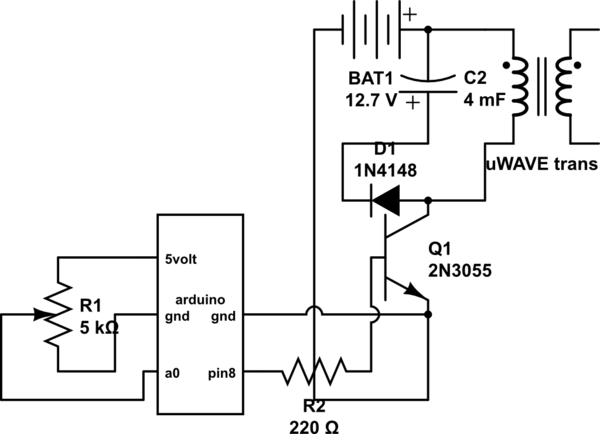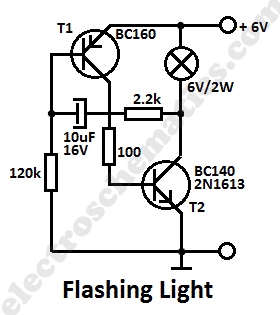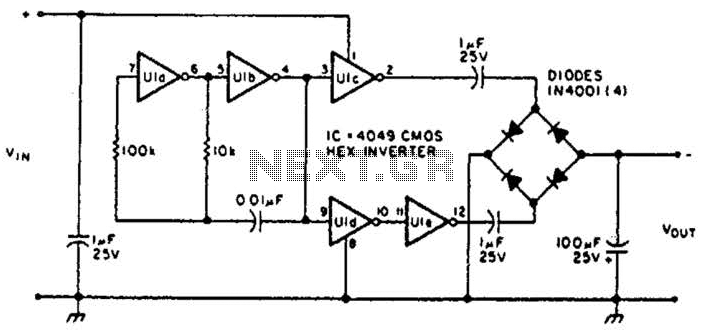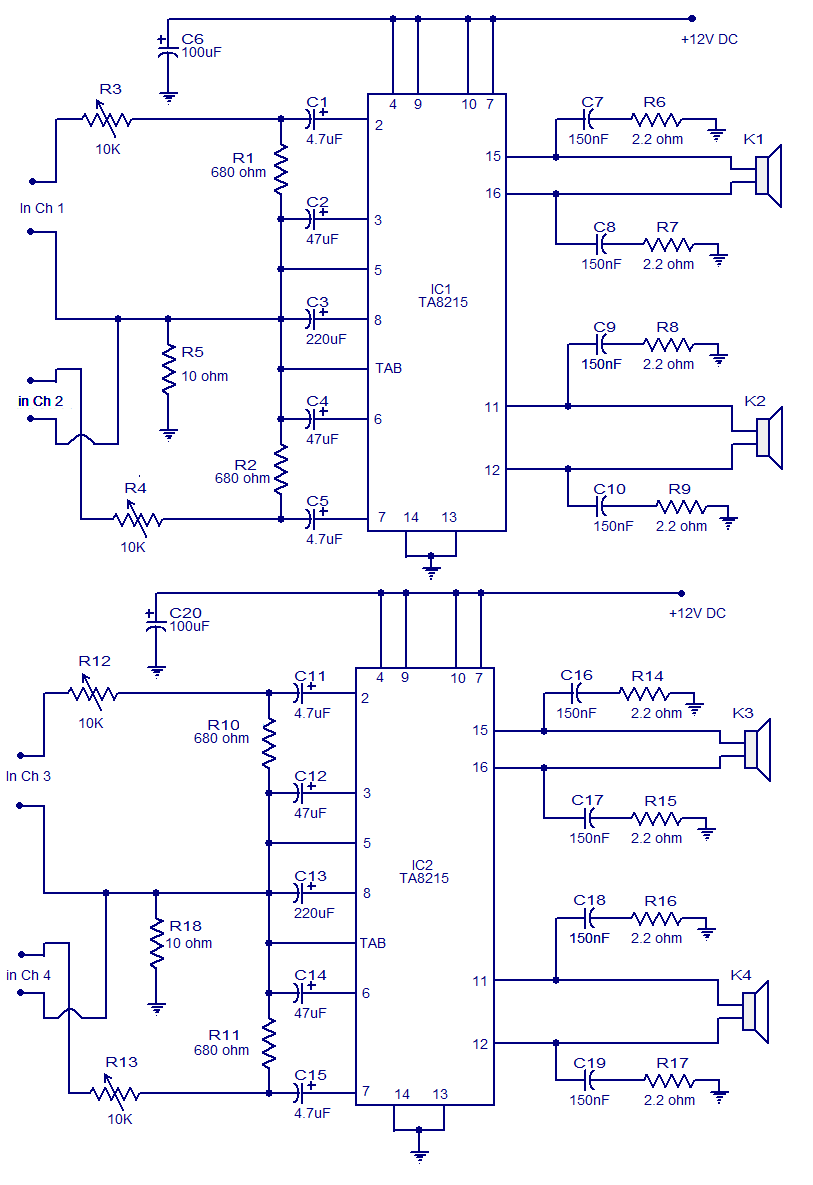
arduino pulse to transistor power maximum

If both devices need to be powered from the battery, should the emitter be connected to the ground of the Arduino and the battery to prevent current from flowing through the Arduino ground, ensuring a clean pulse? Alternatively, can the emitter be connected to the battery negative, allowing the signal to function correctly? In the optimal configuration, where should an analog meter rated for up to 3 amps be placed to monitor the total power consumption of the board and the transistor circuit? Additionally, the setup involves pulsing the high voltage side coil of a microwave transformer, which has significant impedance and draws approximately 300 mA maximum when pulsed. Is it feasible to power the Arduino via USB while powering the transistor from the battery, allowing for on-the-fly reprogramming and a fixed pulse instead of using a potentiometer? Specifically, can the code be written for a specific delay and uploaded while running? Is there an intentional varying delay of 'n' milliseconds, where 'n' is the value read from port A0 each time? Furthermore, is this delay necessary twice, once after setting the output pin high and once after setting it low? A base resistor is required between the pulse (Pin 8) and the base of the 2N3055 transistor, with the value determined by the desired collector current. A minimum of around 220 Ohms is suggested to limit the pulse pin current to approximately 25 mA, which is well within the safe limits, as the absolute maximum for each pin is rated at 40 mA. Powering the Arduino from USB and the transistor from the battery is acceptable, provided the Arduino ground is connected to the negative pole of the battery. The analog meter should be placed in series with the coil being driven if measuring the transistor's collector current. For measuring total current, both the Arduino and transistor should be powered from the battery, with the meter added in series with either the positive or negative pole of the battery, ensuring all current to the battery passes through the meter. Current will follow the path of least resistance, making this arrangement effective. It is advisable to use an optoisolator to separate the two devices, as switching a large current load can induce significant noise into the system. A recommendation is made to consider switching to a MOSFET instead of using the NPN transistor, as power dissipation calculations favor the MOSFET. For the MOSFET, power dissipation is calculated as P = (I^2)(Ron) = (300mA)^2 * (mOhms), resulting in minimal heat generation. In contrast, for the NPN transistor, power dissipation is calculated as P = (I * V) = (300mA) * (0.7V) = 0.21W.
In this circuit configuration, the power supply strategy is crucial for optimal performance and signal integrity. The Arduino can be powered via USB, allowing for convenient programming and debugging, while the transistor, which handles higher currents, is powered directly from the battery. This separation minimizes potential noise and ensures that the Arduino operates reliably without interference from the power demands of the transistor circuit.
The placement of the analog meter is critical for accurate current measurement. When measuring the current through the transistor, the meter should be placed in series with the load (the coil), allowing it to measure the collector current directly. For total current measurement, the meter must be positioned in the battery circuit, ensuring that all current flowing to the Arduino and the transistor passes through the meter, providing a comprehensive view of power consumption.
The use of a base resistor is essential to protect the Arduino pin and control the base current into the 2N3055 transistor. The recommended 220 Ohm resistor ensures that the base current remains within safe limits while providing sufficient drive to saturate the transistor during operation. This configuration will allow the transistor to act effectively as a switch, controlling the high voltage coil with minimal losses.
In addition, the introduction of an optoisolator is recommended to further isolate the Arduino from the high-power circuit. This component will help mitigate noise and protect the Arduino from voltage spikes that may occur during the switching of the high voltage coil.
Switching to a MOSFET can enhance efficiency, as MOSFETs typically exhibit lower on-resistance (Ron) compared to bipolar junction transistors (BJTs) like the 2N3055. This results in lower power dissipation and heat generation, which is particularly advantageous in high-current applications. The choice of MOSFET should be based on the maximum current and voltage ratings required for the application, ensuring it can handle the demands of the microwave transformer coil without overheating.
Overall, careful consideration of component selection, circuit configuration, and measurement techniques will lead to a robust and efficient design capable of handling the specified requirements.If they have to be both powered from the battery do I need to connect the emitter to the ground of the Arduino AND the battery to stop all the current from flowing through the Arduino ground and get a clean pulse or do I just connect the emitter to the battery negative and the signal will be OK. In whatever configuration is best where is the best place to put a analog meter that is rated up to 3 amps
so that I can see total power consumption of the board and the transistor circuit. Lastly I am using this to pulse the high voltage side coil in a microwave transformer so it has a lot of impedance and when pulsing it it draws about 300 mA max so could I power the Arduino via USB and the transistor from the battery so that I can reprogram on the fly and have a set pulse instead of using the pot. (as in write the code for a certain delay and upload while running) Is it intentional to have a varying delay of n milliseconds, where n is the value read from port A0 each time Also, is that delay required twice, once after setting the output pin high, once after setting it low You will require a base resistor between pulse (Pin 8) and the Base of the 2n3055, with a value calculated depending on how much current you intend to allow through the Collector.
If you are using the transistor as a switch, then a minimum of around 220 Ohms is suggested, to keep current from the pulse pin under around 25 mA, well within the safe limits for each pin: Absolute Maximum for each pin is rated at 40 mA. You could power the Arduino from USB and the transistor from the battery, so long as the ground of the Arduino is connected to the negative pole of the battery.
Put it in series with the coil you are driving, if you want to measure the coil (the transistor`s Collector) current. If you want to measure the combination, both Arduino and transistor need to be powered from the battery, and just add the meter in series with either the positive or negative pole of the battery, before any connection to either Arduino or transistor.
i. e. all current to the battery must pass through the meter. 2) Current will find the path of least resistance, so that`s fine. I would use an optoisolator to separate the two devices. Whenever you switch a large current load, a lot of noise will be induced into your system. 4) I would recommend changing to a MOSFET instead of using the NPN transistor. If you do the power dissipation calculation for the two devices, it makes a lot of sense: MOSFET: P = (I2)(Ron) = (300mA2)*(mOhms) => little heat NPN: P = (I*V) = (300mA)*(0. 7V) = 0. 21W 🔗 External reference
In this circuit configuration, the power supply strategy is crucial for optimal performance and signal integrity. The Arduino can be powered via USB, allowing for convenient programming and debugging, while the transistor, which handles higher currents, is powered directly from the battery. This separation minimizes potential noise and ensures that the Arduino operates reliably without interference from the power demands of the transistor circuit.
The placement of the analog meter is critical for accurate current measurement. When measuring the current through the transistor, the meter should be placed in series with the load (the coil), allowing it to measure the collector current directly. For total current measurement, the meter must be positioned in the battery circuit, ensuring that all current flowing to the Arduino and the transistor passes through the meter, providing a comprehensive view of power consumption.
The use of a base resistor is essential to protect the Arduino pin and control the base current into the 2N3055 transistor. The recommended 220 Ohm resistor ensures that the base current remains within safe limits while providing sufficient drive to saturate the transistor during operation. This configuration will allow the transistor to act effectively as a switch, controlling the high voltage coil with minimal losses.
In addition, the introduction of an optoisolator is recommended to further isolate the Arduino from the high-power circuit. This component will help mitigate noise and protect the Arduino from voltage spikes that may occur during the switching of the high voltage coil.
Switching to a MOSFET can enhance efficiency, as MOSFETs typically exhibit lower on-resistance (Ron) compared to bipolar junction transistors (BJTs) like the 2N3055. This results in lower power dissipation and heat generation, which is particularly advantageous in high-current applications. The choice of MOSFET should be based on the maximum current and voltage ratings required for the application, ensuring it can handle the demands of the microwave transformer coil without overheating.
Overall, careful consideration of component selection, circuit configuration, and measurement techniques will lead to a robust and efficient design capable of handling the specified requirements.If they have to be both powered from the battery do I need to connect the emitter to the ground of the Arduino AND the battery to stop all the current from flowing through the Arduino ground and get a clean pulse or do I just connect the emitter to the battery negative and the signal will be OK. In whatever configuration is best where is the best place to put a analog meter that is rated up to 3 amps
so that I can see total power consumption of the board and the transistor circuit. Lastly I am using this to pulse the high voltage side coil in a microwave transformer so it has a lot of impedance and when pulsing it it draws about 300 mA max so could I power the Arduino via USB and the transistor from the battery so that I can reprogram on the fly and have a set pulse instead of using the pot. (as in write the code for a certain delay and upload while running) Is it intentional to have a varying delay of n milliseconds, where n is the value read from port A0 each time Also, is that delay required twice, once after setting the output pin high, once after setting it low You will require a base resistor between pulse (Pin 8) and the Base of the 2n3055, with a value calculated depending on how much current you intend to allow through the Collector.
If you are using the transistor as a switch, then a minimum of around 220 Ohms is suggested, to keep current from the pulse pin under around 25 mA, well within the safe limits for each pin: Absolute Maximum for each pin is rated at 40 mA. You could power the Arduino from USB and the transistor from the battery, so long as the ground of the Arduino is connected to the negative pole of the battery.
Put it in series with the coil you are driving, if you want to measure the coil (the transistor`s Collector) current. If you want to measure the combination, both Arduino and transistor need to be powered from the battery, and just add the meter in series with either the positive or negative pole of the battery, before any connection to either Arduino or transistor.
i. e. all current to the battery must pass through the meter. 2) Current will find the path of least resistance, so that`s fine. I would use an optoisolator to separate the two devices. Whenever you switch a large current load, a lot of noise will be induced into your system. 4) I would recommend changing to a MOSFET instead of using the NPN transistor. If you do the power dissipation calculation for the two devices, it makes a lot of sense: MOSFET: P = (I2)(Ron) = (300mA2)*(mOhms) => little heat NPN: P = (I*V) = (300mA)*(0. 7V) = 0. 21W 🔗 External reference





